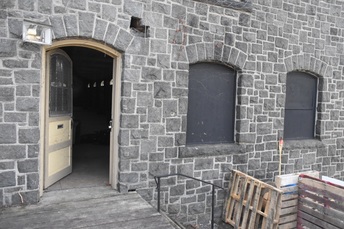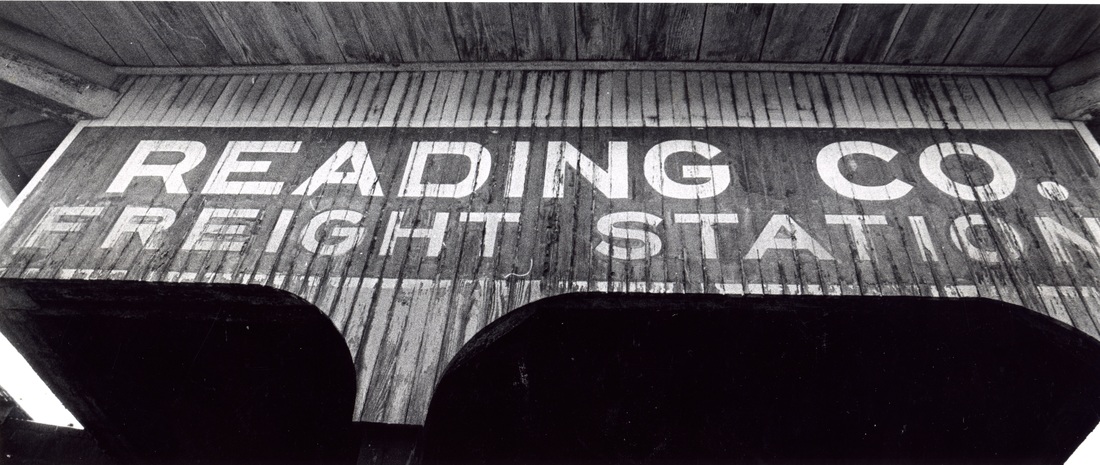THE HISTORIC FREIGHT HOUSE :
A symbol of Lansdale's heritage, and its future


By DICK SHEARER, Historian
Lansdale Historical Society
More than a century ago, when railroads ruled the transportation world, towns and cities alike were judged by their train stations. Communities with large, ornate passenger depots surrounded by colorful gardens made a tremendously positive impression on first-time visitors.
Lansdale landed in that category in 1903 when a brand-new passenger station was put into service here. The Philadelphia and Reading Railroad boasted the station was its grandest between Philadelphia and Bethlehem.
It generated a sense of community pride among the townspeople. No longer would Lansdale have to play second-fiddle to nearby Colonial-era boroughs such as Norristown and Doylestown that predated it in age and influence. Lansdale found its own niche; the railroad was its baby.
The new depot was without question the centerpiece of downtown Lansdale; it garnered all the accolades. But an equally important construction project was taking place a block down the tracks that was every bit as important in the town’s growth and development.
Lansdale grows up
Up until 1903 passengers and freight jockeyed for space in the old wooden station built in 1868 when Lansdale was only a village. By the turn of the 20th century, the aging depot was too small to adequately handle even one of these tasks. Plans were drawn up, and in 1902 construction began on two depots, one for passengers and the other for freight.
The P&R deemed it necessary to build a separate freight station large enough to process the large volume of goods being manufactured by Lansdale’s industries. Companies including the Heebner and Sons Agricultural Works, the Abram Cox Stove Works, Centennial (Flour) Mills, the Krupp Foundry and others were shipping products regionally and nationwide. Local farmers were also depending on the rails to get their produce to market.
Lansdale was the epicenter for transporting these goods because they could be shipped in four directions, eliminating expensive and time-consuming transfers.
The location of the new freight station was all-important. It had to be placed within the short block-and-a-half stretch that the Doylestown and Stony Creek branches share with the Philly-to-Bethlehem main line. That is why it was built just east of Broad Street rather than adjacent to the passenger depot.
Local stonemasons
The stone work for the freight station was contracted to the Boyles family of Lansdale, the best-known stone masons in these parts. Today the basic building looks very much like it did when goods were hauled by horse and wagon to the station for shipment. Eight loading bays on each side of the station expedited the work flow.
The interior features a large 130 by 35- foot open space that at one time included a 30 by 35-foot two-story area for offices and communications equipment. The outdoor deck that extended from the depot to Broad Street was sheltered by a roof and contained a crane for heavy lifting. The roof was destroyed by fire in the 1970s, and the deck has been in a state of disrepair ever since.
Few of today’s Lansdale residents are old enough to remember the freight station in its heyday. Beginning in the 1930s, improved highways and larger, stronger trucks sapped business from the railroads. World War II provided a brief reprieve but the post-war economic boom and the interstate highway network cut deeply into use of trains by passengers and freight shippers.
Just as the Lansdale freight station opened without fanfare late in 1902, it closed with little notice in the 1970s. Times changed. What had once been one of Lansdale’s most important buildings became excess baggage for the railroad. And the freight station stood silent and empty, waiting for its next chapter to begin.
The press release announcing the purchase:
LANSDALE, Pa., June 6, 2016 – Discover Lansdale, the nonprofit dedicated to helping the borough grow as a vibrant and evolving destination for businesses and families, today announced its purchase of a historic former Reading Co. freight station in an effort to preserve a vital piece of Lansdale’s heritage.
The purchase of the structure, located at the intersection of South Broad and Vine Sts., was part of a multi-stage agreement between the previous owners and the Lansdale Parking Authority. The authority purchased the entire property from those owners to increase the inventory of parking spots in the borough; Discover Lansdale then self-funded the purchase of the building for $60,000 from the Authority, and signed a 99-year lease with the Authority for the land on which it sits.
“We are thrilled to contribute to the preservation of this piece of Lansdale’s history,” said Mary Fuller, Discover Lansdale’s president. “Just as the railroad began our town’s development as a center of commerce, the freight station played a key role as the departure point for Lansdale-made goods and products that were shipped around the world.”
Fuller noted that, aside from the historic aspects, the freight station offers myriad possibilities for future use. “The interior is a huge open space from end to end (130 by 35 feet), just what it was originally. This makes it adaptable for so many possibilities.”
The station, which has been unoccupied for more than three decades, was constructed in 1903 and holds an important place in Lansdale’s history. For many years it served as the shipping terminal for the town’s major industries, including the Heebner Agricultural Works, the Cox Stove Works, Franklin/American Olean Tile Co., Lansdale Tube Co. and numerous large hosiery mills. It was also a transfer terminal for goods destined for Norristown or Doylestown.
The structure’s massive stone walls were constructed by the Boyles family, local stonemasons whose workmanship was highly regarded in the community. With the exception of the platform roof and several overhangs, the building looks much as it did in 1903, and is generally structurally sound, although relatively extensive rehabilitative work will need to be done before it can be occupied.
Discover Lansdale has allocated additional funds to begin that process. Efforts to save the freight station have been under discussion for more than a decade. Among those concerned about the building’s fate has been the Lansdale Historical Society, which included it among its list of most endangered historic structures in Lansdale.
“We’re breathing a sigh of relief,” said Dick Shearer, society historian and a Discover Lansdale board member. “Over the years the town gained a reputation – justified or not – of tearing down historic buildings then regretting it later. This is a great start at reversing that trend.”
Discover Lansdale plans to form a committee among multiple community stakeholders to oversee restoration efforts and to examine potential community uses for the building. Suggestions from past proposals include a railroad museum, a Lansdale visitors’ center, a larger display venue for the Lansdale Historical Society, and a year-round marketplace for local farmers and vendors.
Questions or comments please contact:
Mary Fuller, Discover Lansdale President
215-527-6562
[email protected]
or
Dick Shearer, Lansdale Historical Society
215-368-0279
[email protected]
The purchase of the structure, located at the intersection of South Broad and Vine Sts., was part of a multi-stage agreement between the previous owners and the Lansdale Parking Authority. The authority purchased the entire property from those owners to increase the inventory of parking spots in the borough; Discover Lansdale then self-funded the purchase of the building for $60,000 from the Authority, and signed a 99-year lease with the Authority for the land on which it sits.
“We are thrilled to contribute to the preservation of this piece of Lansdale’s history,” said Mary Fuller, Discover Lansdale’s president. “Just as the railroad began our town’s development as a center of commerce, the freight station played a key role as the departure point for Lansdale-made goods and products that were shipped around the world.”
Fuller noted that, aside from the historic aspects, the freight station offers myriad possibilities for future use. “The interior is a huge open space from end to end (130 by 35 feet), just what it was originally. This makes it adaptable for so many possibilities.”
The station, which has been unoccupied for more than three decades, was constructed in 1903 and holds an important place in Lansdale’s history. For many years it served as the shipping terminal for the town’s major industries, including the Heebner Agricultural Works, the Cox Stove Works, Franklin/American Olean Tile Co., Lansdale Tube Co. and numerous large hosiery mills. It was also a transfer terminal for goods destined for Norristown or Doylestown.
The structure’s massive stone walls were constructed by the Boyles family, local stonemasons whose workmanship was highly regarded in the community. With the exception of the platform roof and several overhangs, the building looks much as it did in 1903, and is generally structurally sound, although relatively extensive rehabilitative work will need to be done before it can be occupied.
Discover Lansdale has allocated additional funds to begin that process. Efforts to save the freight station have been under discussion for more than a decade. Among those concerned about the building’s fate has been the Lansdale Historical Society, which included it among its list of most endangered historic structures in Lansdale.
“We’re breathing a sigh of relief,” said Dick Shearer, society historian and a Discover Lansdale board member. “Over the years the town gained a reputation – justified or not – of tearing down historic buildings then regretting it later. This is a great start at reversing that trend.”
Discover Lansdale plans to form a committee among multiple community stakeholders to oversee restoration efforts and to examine potential community uses for the building. Suggestions from past proposals include a railroad museum, a Lansdale visitors’ center, a larger display venue for the Lansdale Historical Society, and a year-round marketplace for local farmers and vendors.
Questions or comments please contact:
Mary Fuller, Discover Lansdale President
215-527-6562
[email protected]
or
Dick Shearer, Lansdale Historical Society
215-368-0279
[email protected]


